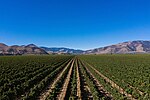Mission Nuestra Señora de la Soledad

Mission Nuestra Señora de la Soledad (Spanish: Misión Nuestra Señora de la Soledad), commonly known as Mission Soledad, is a Spanish mission located in Soledad, California. The mission was founded by the Franciscan order on October 9, 1791, to convert the Native Americans living in the area to Catholicism. It was the thirteenth of California's Spanish missions, and is named for Mary, Our Lady of Solitude. The town of Soledad is named for the mission. After the 1835 secularization of the mission and the later sale of building materials, the mission fell into a state of disrepair and soon after was left in ruins. A restoration project began in 1954 and a new chapel was dedicated in 1955. The chapel now functions as a chapel of Our Lady of Solitude, a parish church of the Diocese of Monterey. The priests' residence was later recreated, and functions as a museum.
Excerpt from the Wikipedia article Mission Nuestra Señora de la Soledad (License: CC BY-SA 3.0, Authors, Images).Mission Nuestra Señora de la Soledad
Fort Romie Road, Soledad
Geographical coordinates (GPS) Address Phone number Website Nearby Places Show on map
Geographical coordinates (GPS)
| Latitude | Longitude |
|---|---|
| N 36.404618833333 ° | E -121.35580683333 ° |
Address
Iglesia de Nuestra Señora de la Soledad
Fort Romie Road 36641
93960 Soledad
California, United States
Open on Google Maps






